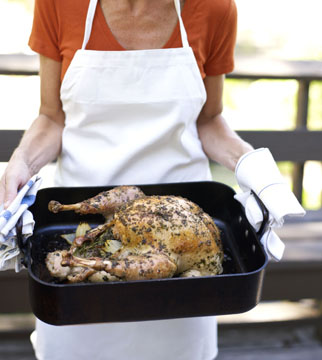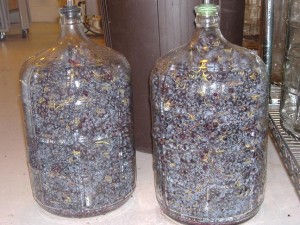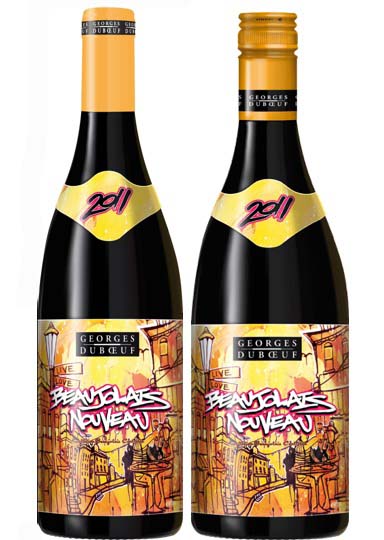This article came through on the
Wine Spectator. I thought it was a nice wrap up of this 2011 harvest season and what to expect from the wines you will see coming to the market fairly soon.
The original article was published by
Wine Spectator. It is pasted here for your convenience.
2011 Vintage Report: United States
A first look at vintage quality in U.S. wine regions, with eyewitness reports from growers and winemakers
Posted: November 18, 2011
This is the fifth of Wine Spectator's reports on the 2011 vintage in the northern hemisphere. All this week, we'll be bringing you harvest details from winemakers throughout Europe and North America. (See the sidebar links for reports on California, France, Italy and other areas of Europe.)
The 2011 growing season was challenging on both coasts. Washington suffered a damaging freeze this past November. Oregon watched a cloudy summer drag the season out. And New York and Virginia watched storm after storm pound their vines all fall. Vineyard management was all-important no matter where you made wine. As for final quality in the bottle, it's too early to know. But here's a sneak peek.
Crates of grapes wait for the trip to the winery at Virginia's Chrysalis Vineyards. (Photo from original article) |
New York
Finger Lakes
Finger Lakes vintners were put to the test in 2011, as the region dealt with its most difficult growing season in recent memory. With heavy rains falling from mid-August through harvest, New York's upstate wine region struggled with disease pressures and uneven ripening that could result in a very inconsistent set of wines.
“I have seen some of the worst grapes ever this year,” said Morten Hallgren of Ravines Wine Cellars on Keuka Lake. “I have also seen beautiful, impeccably clean grapes. It is most definitely a year to evaluate growers and sites. The growers who didn't stay on top of their spray program were shown no mercy.”
The 2011 growing season started with a rainy April and May, but by June, warm, dry weather dominated and growers began to become more optimistic. “Bullet dodged, or so we thought,” said Peter Bell, winemaker at Seneca Lake's Fox Run, about the spate of dry weather that began in midseason. “But the drought was horrendous, as it didn't rain again until the first week of August and the vines had stopped photosynthesizing in early July.”
As the first rains arrived in August, they came as a relief, helping vines recover. “We saw some good sugar accumulation through mid-September,” said Bell. But the rains continued persistently through September.
“The problem was that the vineyards never really could dry out,” said Johannes Reinhardt, winemaker at Anthony Road Winery on Seneca Lake. “Acid and pH bounced around like never before as flavors and sugars essentially 'froze.' It was just a matter of time before botrytis kicked in.”
With no relief in sight from the late-season rains, growers were forced to pick early for fear of rot. The resulting wines are likely to be light-bodied and lean in style, though Riesling, the region's lead vinifera grape, could produce some successes. “Some vineyards that I source from looked pretty normal with minimal disease, showing bright, vibrant flavors,” said Dave Whiting, winemaker and owner at Red Newt Cellars on Seneca Lake. “But there was a lot of diversity from vineyard to vineyard in terms of maturity, botrytis and bunch rot.”
With the vintage's inconsistent performance, sorting in both the vineyard and winery will likely prove critical to success. “This year we found that paying the picking crew by hour, rather than by picking basket, resulted in much cleaner fruit arriving to the winery,” said Tom Higgins of Heart & Hands Winery on Cayuga Lake. "And we still hand-sorted a fair bit to eliminate anything that might have been missed."
—James Molesworth
Long Island
"No year out here is easy, but this year really wasn't easy," said Richard Olsen-Harbich, describing the 2011 growing season on Long Island's East End. Olsen-Harbich is winemaker at Bedell Cellars and has made wine on Long Island for more than 30 years. "We had a lot of rain, an earthquake. We also had a lot of heat." Despite the challenges, the year was not as dire as some prior seasons. Most Long Island vintners believe that as long as they labored hard in the vineyards, they could make good wines this year.
The earthquake that struck the East Coast in August did little harm to the grapes, but the rain was a bigger challenge. Hurricane Irene did most of her damage further west, dumping a little under 2 inches on the North Fork and the Hamptons. But the remnants of Tropical Storm Lee lumbered by two weeks later, bringing another 4 inches. All the wet weather raised the threat of mildew and botrytis. "The season was very challenging with all that rain," said Roman Roth, winemaker at Wölffer Estate, Roanoke Vineyards and his own label, The Grapes of Roth.
Vineyard work was crucial. Many vintners dropped a lot of fruit to allow what was left to ripen more fully. Canopies had to be managed to allow the wind to dry the grapes and prevent rot. "This kind of vintage is kind of exhilarating," said Olsen-Harbich. "This kind of year separates the men from the boys."
It was also a very warm growing season, one of the warmest on record, which increased the chances of fungus but also helped ripen the fruit. Roth reports that his red grapes' tannins ripened quickly, allowing him to simply wait for sugars to catch up and pick when he wanted. He got to 22.5 Brix in his Merlot before a late-October frost forced the vines to drop their leaves and he sent out his pickers.
2010's ideal weather helped Long Island produce very ripe, structured reds. This year, the weather produced more elegance. "The 2010 reds were more extracted," said Olsen-Harbich. "We have more Mozart on the palate this year." He was especially happy with his Cabernet Franc and Viognier. Roth said his Merlots were rich but should be approachable earlier than his 2010 Merlots.
—Mitch Frank
Oregon
For four months, 2011 vintage looked like a disaster waiting to happen for Oregon vintners. The vines produced a huge crop and it didn't look as if conditions would ever get warm enough to ripen it. It was, in the end, the latest vintage in Oregon history. Most wineries didn't start picking until after Oct. 15, and were still picking in the first week in November.
Most of the grapes were brought in under warm, sunny skies. Rain was forecast in late September and early October, but only a few showers materialized. Alcohols were low, about the same as in 2010, but color and flavor surprised vintners with their depth. They are calling it a miracle vintage.
"We were saved by an Indian summer,” said Sam Tannahill, the partner responsible for winemaking at A to Z Wines and Rex Hill. "We have not pressed many tanks yet, but the ones that we have are beautiful—fine color, great elegance, fantastic depth and moderate alcohol. Really, really nice wines.”
Not only did the late fall weather save the vintage, vintners said, but it compared favorably with any vintage of the past 10 years. Harry Peterson-Nedry, proprietor of Chehalem Vineyards, compared it to 2008, 1999 and 1993. Others concurred. "I'm very encouraged by what we see, with very little water on anything, long hang times, low but adequate sugars for low alcohols, complete flavors and acids," reported Peterson-Nedry.
In late summer the vines held very large clusters, often two or three times normal size. Fearing they would never ripen completely, David O'Reilly of Owen Roe purchased 1,000 pounds of sugar to chaptalize (which is legal in Oregon, as it is in Burgundy). "We hardly used any," he said. "I think that the hang time has contributed good flavors and the decent weather caused some shrinkage in clusters, reducing the overall cluster weights."
—Harvey Steiman
Virginia
If Virginia winegrowers had to sum up 2011 in one word, they'd choose "wet." This was a growing season that tried vineyard managers' patience, as they tried to prevent mildew, botrytis and rot from destroying grapes before they could ripen. September and October brought storm after storm.
The problem was the rain," said Gabriele Rausse, of Gabriele Rausse Winery near Monticello. "The grapes' chemistry was almost right, and then a big rain diluted everything. You waited a few days and another big rain brought you back where you started. Eventually, the fruit was starting to rot and you had to give up."
The spring was warm and wet in most of Virginia's wine regions, including the Monticello appellation near Charlottesville and the area near Middleburg farther north. Summer brought sunny, warm weather, with occasional rain. But the wet weather began when Hurricane Irene passed over the region in late August and the remnants of Tropical Storm Lee came just two weeks later.
Most growers hoped that timely spraying and vineyard management, coupled with a sunny fall, could save the season. But the rain would not go away. "We had high hopes that it would stop raining and that everything would dry out nicely," said Kirsty Harmon, winemaker at Blenheim Vineyards. "We had some dry days that allowed us to pick, but we did more sorting in the vineyard than I have ever done before."
White varieties like Viognier and Chardonnay ripened early enough and were in decent shape when picked. But Cabernet Franc, Merlot, Petit Verdot and especially Cabernet Sauvignon suffered as the rain continued. "We are most excited about Merlot and Cabernet Franc—a little less concentration but very good structure and acids were maintained," said Rachel Martin of Boxwood Winery. "Our biggest challenge was Cab Sauv—poor weather made both ripening and harvest difficult."
—M.F.
Washington
The defining event of Washington's 2011 vintage occurred in 2010—a late-November freeze damaged vines across the state, particularly in the Horse Heaven Hills and Walla Walla appellations. A cool summer led to the latest harvest on record for many vintners. Despite alcohol levels slightly lower than normal, experienced vintners reported rich flavors.
"This was a very late harvest," said Chris Camarda of Andrew Will Wines, who was still waiting to finish picking his last vineyard (Two Blondes in Yakima Valley) Nov. 8. "The wines I have in barrel have good concentration and balance along with an almost muscular feel about them. They are certainly made from fully ripe fruit."
"It will be a year when consumers need to make decisions not just on [appellation], but on specific vineyards and specific wineries," said Bob Betz of Betz Family Wines. "The weather demanded precise steps by our growers: reducing yields, canopy management for light penetration and disease prevention, and even then we had [sugar] levels that were 1 to 2 degrees lower than typical. But the fruit was physiologically ripe."
"Warm years in many ways are more forgiving," Betz added. “A cool year like this one has made me appreciate even more who the really exceptional growers in the state are."
Vintners reported moderate acidity levels and low pHs, a measure of how tart the wines could be. This is an unusual combination, Betz noted. "Low total acid will give us a pleasurable balance while the low pH will provide stability and longevity. Flavors are full, complete and rich. So much pepper in Mourvèdre, smoke in Syrah, currants in Cabernet. No greenness."
One grower, Hugh Shiels of DuBrul Vineyard in Yakima Valley, described his Cabernet Sauvignon as his most ageworthy Washington Cabernet ever. He credited cool ripening conditions after the grapes changed color, promoting flavor development while sugar accumulation was slow.
—H.S.
















